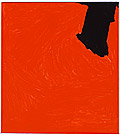Mirdidingkingathi JUWARNDA Sally GABORI

When depicting Dibirdibi Country, Mirdidingkingathi Juwarnda Sally Gabori often depicts the hunting ground in the sea of her father’s Country, where her big brother Bardi (Buddy) and her cousin Gilbert used to hunt for dugong. A champion dugong hunter, in the days when dugongs were wrestled rather than being caught by harpoons, Bardi would never let one get away.
Gabori talks about how her mother, Mara, died when Gabori was very young, how her big brother Buddy brought her up and how her (future) husband Pat was a great fighter and seducer—he took away the wives of many other men and made them pregnant. She also spoke about the freshwater billabong at Nyinyilki. It has lots of casuarina trees and fresh water, which people would scoop up in baler and trumpet shells.
The colours and shapes of the places depicted in these paintings are interwoven with memories of life on Bentinck Island before white people came, of her big brother growing her up after the death of her mother, of the hunting prowess of her brother, her father and her husband Pat, of fighting over women and of the haunting songs that would be sung about kin who were off hunting or who had passed away.[1]
In 2005, the vivid works of Kaiadilt artist Mirdidingkingathi Juwarnda Sally Gabori took the Aboriginal art world by surprise. Her vibrant palette and expressive brushwork in compositions offering a unique visual language demanded attention. Gabori had only begun painting earlier in the year after materials were made available to her at Mornington Island Arts and Crafts Centre. She was introduced to the centre as a weaver. However, after collecting materials for string on her initial visits, she began painting, and it was clear that she had something exceptional to offer. In a few short months, she achieved a remarkable rise to fame. Gabori has since built on this success, and her works of art continue to evolve and delight.
The strength of Gabori’s works and the confidence with which she paints show a lifetime of experiences distilled to their most potent visual form. Her works focus on her homeland of Bentinck Island in the Gulf of Carpentaria. Gabori was born there around 1924 and spent her youth learning the intricacies of Kaiadilt life, including the art of rolling bark string and making dilly bags and coolamons. She also played a vital role in maintaining the stone-walled fish traps on the shores of the island, which provided the majority of the food supply.
Although not far from the coast of mainland Australia, the Kaiadilt people of Bentinck Island had little outside contact. This changed dramatically in 1948, when the Kaiadilt were moved to nearby Mornington Island due to social and environmental factors. Now living on the lands of the Lardil people, the Kaiadilt retained much of their culture, but the move had a deep impact and left an immense longing for home. Although Gabori continues to live on Mornington Island, one of the most rewarding outcomes from her artistic success has been her ability to more readily visit Bentinck Island.
Gabori’s works are a celebration of her homeland and illustrate a deep connection to Country that has not diminished through physical separation. From her very earliest works, she has depicted aspects of her own beloved Country as well as that of her brother, father and husband—including both geographical aspects of the landscape as well as the wildlife, specifically sea-life, which is central to the landscape.
Gabori’s expressive application of paint with thick brushstrokes and overlay of colours shows the immediacy with which she works and indicates an enjoyment of the act of painting itself. Over time, she has eliminated the surplus detail from her work while exploring the potential of her painting technique to dramatic effect. This is exemplified in My grandfather’s Country 2009. In this work, the geometric forms that dominated her early works have dissolved and the directional application of paint in subtle variations of colour and texture dominates.
In Nyinyilki 2010, this painterly technique is further explored and successfully combined with Gabori’s striking use of black paint. Elegant, crevice-like forms seem to recede into the vast field of textural white paint, with the gestural brushwork enhanced through the inclusion of subtle tonal greys. In other works, such as Nyinyilki 2009, her use of colour comes to the fore. Bold fields of vibrant, roughly applied colour dazzle the eye with their luminosity.
Gabori has an amazing ability to develop her work and captivate with each of her styles and with her incredible use of colour. She offers a minimalism that is intriguing.
Cara Pinchbeck
[1] Professor Nicholas Evans, interpreted from the artist’s explanation of her paintings in her Kayardild language, June 2010. Kayardild is the language of the Kaiadilt people.



